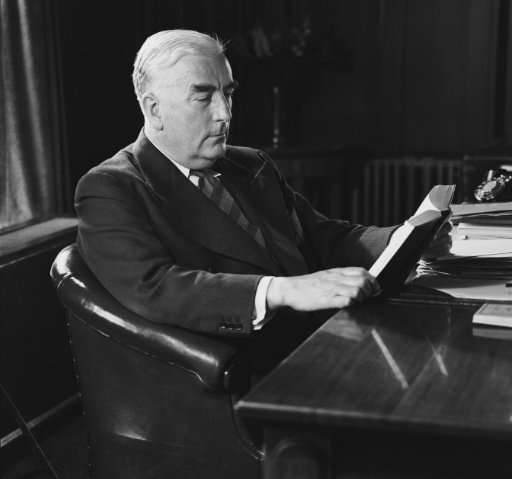On this day, 20 November 1953, Robert Menzies introduces the Flags Bill to Federal Parliament, establishing that the Commonwealth Blue Ensign is the official national flag. The Bill also specifies colours and construction details for the flag, ensuring that each element is in exact proportion to the others. The Flags Act was notably given Royal Assent by the Queen in person during the royal tour of 1954, rather than by the Governor-General, a signal of its symbolic importance.
The Blue Ensign flag had originally been chosen by a national competition held shortly after federation. This attracted over 30,000 designs, with five almost identical entries sharing the £200 prize on offer. The competition was judged in the Royal Exhibition Building in Melbourne and involved the Melbourne-based publication the Review of Reviews, which had begun organising a flag competition before the Commonwealth Government got involved. The new flag controversially replaced the New South Wales Ensign which had been used as the main national flag during the campaign for federation, and it was first flown in Melbourne on 3 September 1901.
The Blue Ensign closely resembles the flag of the Anti-Transportation Leagues, the movement to end convict transportation which was the first to politically unite the various colonies of Australasia, with the addition of the Commonwealth Star representing the six States and the Territories of the Commonwealth. However, the Blue Ensign also closely resembles the Victorian flag, which was created after the Anti-Transportation campaign, and it was for this reason that the flag choice has been criticised as representing a Victorian dominance of the early Commonwealth, particularly as the Federal Parliament initially sat in Melbourne.
While the Blue Ensign has thus been the national flag since it received royal approval in 1902, there was confusion across the general public about when and what flag to use, mainly due to the Government limiting the flying of the Blue Ensign to official buildings. This issue of exclusivity meant that private citizens were encouraged to instead fly the Red Ensign for the first few decades of the Commonwealth’s existence.
It was Menzies who had encouraged the wide-spread adoption of the Blue Ensign. As Prime Minister in 1941 he issued a statement recommending that the Blue Ensign be flown at schools, government buildings and by private citizens, providing it was done so respectfully, and that the Red Ensign should be maintained for merchant ships.
Over the next decade this became normalised, such that when introducing the 1953 Bill Menzies said ‘this bill is very largely a formal measure which puts into legislative form what has become almost the established practice in Australia … The design adopted was submitted to His Majesty King Edward VII, and he was pleased to approve of it as the Australian flag in 1902. However, no legislative action has ever been taken to determine the precise form of the flag or the circumstances of its use, and this bill has been brought down to produce that result’.
In 1998, during the debate over the possible creation of an Australian Republic, the Flags Act was amended to ensure that the national flag could only be changed via a plebiscite which secured the backing of a majority of electors. Recent polling suggests that this is unlikely to happen any time soon, and that the Blue Ensign remains an immensely popular symbol of Australia, having secured the national pride of place that Menzies’s Flags Bill intended for it.
Further Reading:
Elizabeth Kwan, Flag and Nation (UNSW Press, 2006).
William Coleman, Their Fiery Cross of Union: A Retelling of the Creation of the Australian Federation, 1899-1914 (Connor Court, 2021).
Sign up to our newsletter
Sign up for our monthly newsletter to hear the latest news and receive information about upcoming events.


